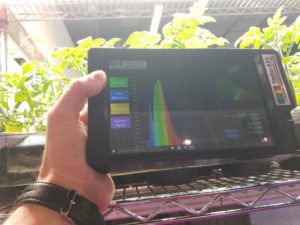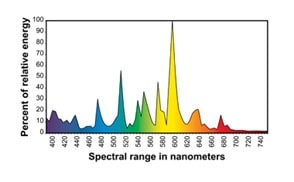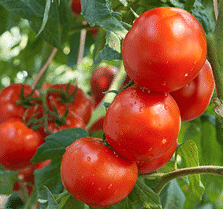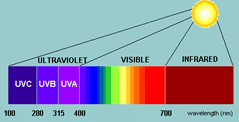For millennia, farmers have been at the mercy of the sun, depending on it to grow quality crops. Then came metal halide lamps and greenhouses to create artificial sun and summer. Now, with technologies such as LEDs, crops can be grown with tailored spectral distributions. Metal halide lamps are blackbody radiators, which means they have a broadband spectrum and generate heat. LEDs emit narrow wavelengths and no heat. This means that LEDs can target specific photoreceptors in plants – such as chlorophylls, which  absorb blue light, and photosystems, which absorb red light – to influence how the plants grow. Conversely, UV light – which generates free electrons and causes oxidative stress – can be used to improve sensory qualities, like taste and smell. Stress generally causes plants to activate metabolisms that contribute to their sensory qualities. For example, the California drought stressed wine grape vines in Napa and produced some of the best recent vintages.
absorb blue light, and photosystems, which absorb red light – to influence how the plants grow. Conversely, UV light – which generates free electrons and causes oxidative stress – can be used to improve sensory qualities, like taste and smell. Stress generally causes plants to activate metabolisms that contribute to their sensory qualities. For example, the California drought stressed wine grape vines in Napa and produced some of the best recent vintages.
With such a wide array of possibilities, it is crucial to characterize light sources carefully. This can easily be accomplished with StellarNet’s line of spectrometers for the UV and visible ranges, aided by light receptor accessories. Here are a few examples of how StellarNet spectrometers are being used to do just that:
Metal Halide Lamps Versus LEDs
Bergstrand et. al. tested how LEDs and HPS lamps affected the growth of roses and tomatoes when both light sources had the same  photosynthetically active radiation (PAR) intensities [1]. They used a BLUE-Wave spectrometer to characterize the light sources and ensure that the same PAR intensities hit the plants. The LEDs caused more photosynthetic activity in the plants, but the HPS lamps induced greater leaf areas and also penetrated the canopy more efficiently. These competing effects led to no significant difference in the fresh and dry weight between the treatments.
photosynthetically active radiation (PAR) intensities [1]. They used a BLUE-Wave spectrometer to characterize the light sources and ensure that the same PAR intensities hit the plants. The LEDs caused more photosynthetic activity in the plants, but the HPS lamps induced greater leaf areas and also penetrated the canopy more efficiently. These competing effects led to no significant difference in the fresh and dry weight between the treatments.
Gómez and Mitchell also compared HPS lamps and LEDs, but they decided to place the LEDs within the canopy of the plants, which is possible because LEDs do not generate heat [2]. They used a BLUE-Wave spectrometer to calibrate a handheld light meter to measure the photosynthetic photon flux density (PPFD) at different heights among the plants. The authors also found that the plants subjected to LEDs had more photosynthetic activity, but the yields
were similar between the treatments. This suggests that the placement of the LEDs may not matter. However, the LEDs still performed better than the control. The authors also measured energy consumption of the light sources and found that LEDs consumed less energy, as expected.
Improving Sensory Quality With UV-A Light
A common complaint among grocery shoppers is that greenhouse tomatoes do not have as much flavor as open field grown tomatoes. Dzakovich et. al. hypothesized that this is because greenhouses block UV light [3]. They used UV bulbs, characterized by a BLACK-Comet, to subject tomatoes to UV-A light (315-400 nm) and UV-A+B light (285-400 nm). Many compounds in the tomatoes were measured in an attempt to find a chemical culprit for taste, but none of the compounds measured in the study were affected by the treatments. However, in a randomly designed taste test, subjects indicated that the UV-A treated tomatoes tasted better than the UV-A+B treated tomatoes and the control tomatoes. The authors speculated (with literature support) that volatile organic compounds, not measured in the experiment, were the likely cause of the increased quality.
tomatoes. Dzakovich et. al. hypothesized that this is because greenhouses block UV light [3]. They used UV bulbs, characterized by a BLACK-Comet, to subject tomatoes to UV-A light (315-400 nm) and UV-A+B light (285-400 nm). Many compounds in the tomatoes were measured in an attempt to find a chemical culprit for taste, but none of the compounds measured in the study were affected by the treatments. However, in a randomly designed taste test, subjects indicated that the UV-A treated tomatoes tasted better than the UV-A+B treated tomatoes and the control tomatoes. The authors speculated (with literature support) that volatile organic compounds, not measured in the experiment, were the likely cause of the increased quality.
In a similar vein, Miyauchi et. al. sought to discover how different wavelengths of light affected the quality of green tea leaves [4]. They  used a StellarNet spectrometer to measure the spectral distribution of their LEDs and fluorescent lamps. Then, they examined how far-red (700-800 nm), white, and UV-A light affected the quality of the tea leaves by measuring the amino-acid profiles and comparing the profiles to entries in a contest. They found that UV-A light led to similar amino-acid profiles to leaves that scored high in the contest, suggesting that UV-A light could lead to improved quality, like with the tomatoes.
used a StellarNet spectrometer to measure the spectral distribution of their LEDs and fluorescent lamps. Then, they examined how far-red (700-800 nm), white, and UV-A light affected the quality of the tea leaves by measuring the amino-acid profiles and comparing the profiles to entries in a contest. They found that UV-A light led to similar amino-acid profiles to leaves that scored high in the contest, suggesting that UV-A light could lead to improved quality, like with the tomatoes.
Manipulating Plant Responses by Varying Color Ratios
The sun’s red light (600-700 nm) to far-red light (700-800 nm) ratio is ~1. When a plant is shaded by other plants, red light gets absorbed, the red to far red (R:FR) ratio decreases, and the plant knows that it has to get out of the shade. Shibuya et. al. tried to modify the shade-avoidance response of cucumber plants by exposing them to fluorescent lamps with a R:FR of ~11 [5]. They used a BLACK-Comet-SR to measure the spectral distribution of the lamps and calculate the ratio. As hypothesized, the shaded cucumber plants under fluorescent lights kept growing under the shade, instead of avoiding the shade by growing towards the light.
Another study by Petrella et. al. tried to increase anthocyanin production in bluegrass by using different wavelengths of light [6]. Anthocyanins have health-promoting properties, but few plants produce them and even fewer plants produce good yields. The authors used metal halide lamps and blue, red, and far-red LEDs to increase anthocyanin production in bluegrass, measuring spectral distributions with a BLACK-Comet. They found that the optimum light condition was 70% blue light, 30% red light at 200 μmol m-2 s-1 PPFD.
A similar result was found by Frąszczak et. al. with dill [7]. The authors used a BLACK-Comet to measure the flux of visible LEDs in order to find the optimum blue to red ratio for stimulating growth in dill. While the effects of the blue to red ratio were varied for nutrients in the plants, the authors discovered that 60/20% and 50/30% (red/blue) with 20% green and orange were optimum ratios for growth and photosynthesis.
As can be seen, there are a variety of projects even within the field of horticulture that require the use of a spectrometer. Light source characterization is fundamental to each of these projects and requires precise quantities to be measured, such as PPFD. A fundamental and precise measurement deserves a reliable and precise StellarNet spectrometer system.
References
- Bergstrand K-J, Mortensen LM, Suthaparan A, Gislerød HR. Acclimatisation of greenhouse crops to differing light quality. Sci Hortic . 2016;204: 1–7.
- Gómez C, Mitchell CA. Physiological and Productivity Responses of High-wire Tomato as Affected by Supplemental Light Source and Distribution within the Canopy. J Am Soc Hortic Sci. American Society for Horticultural Science; 2016;141: 196–208.
- Dzakovich MP, Ferruzzi MG, Mitchell CA. Manipulating Sensory and Phytochemical Profiles of Greenhouse Tomatoes Using Environmentally Relevant Doses of Ultraviolet Radiation. J Agric Food Chem. 2016;64: 6801–6808.
- Miyauchi S, Yonetani T, Yuki T, Tomio A, Bamba T, Fukusaki E. Quality evaluation of green tea leaf cultured under artificial light condition using gas chromatography/mass spectrometry. J Biosci Bioeng. 2017;123: 197–202.
- Shibuya T, Kishigami S, Takahashi S, Endo R, Kitaya Y. Light competition within dense plant stands and their subsequent growth under illumination with different red:far-red ratios. Sci Hortic . 2016;213: 49–54.
- Petrella DP, Metzger JD, Blakeslee JJ, Nangle EJ, Gardner DS. Anthocyanin Production Using Rough Bluegrass Treated with High-Intensity Light. HortScience. 2016;51: 1111–1120.
- Frąszczak B, Gąsecka M, Golcz A, Zawirska-Wojtasiak R. The effect of radiation of LED modules on the growth of dill (Anethum graveolens L.). Open Life Sciences. 2016;11. doi:10.1515/biol-2016-0008

By Debra McCaffrey, PhD
StellarNet Technical Staff Writer
UC Berkeley Chemistry





